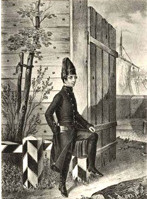
“The Statute on the Emperor Military orphanage” approved
The military schools of the lower category for the soldiers’ children (garrison schools) appeared in Russia under the order of Peter I in 1721. They were further developed in 1732. The schools accepted boys at the age of 7. They were taught to read and write, arithmetic and, according to the school profile, “artillery and engineering”, “soldiers’ training”, “art and handicraft needed for the army and regiments”, military clerks work, metalwork, carpenter work, tailoring, shoe-making and other trades. At the age of 15 the most talented pupils were left in schools for another 3 years of perfection. Others were appointed for the army service.
The new stage in the military schools’ development came with Paul I decision to found in 1795 the Military orphanage for the soldiers’ children deprived of the parents’ care. By the end of 18th century the number of such children had significantly increased due to the great number of wars.
On December 23, 1798 (January 3, 1799) Paul I approved “The Statue on the Emperor Military orphanage”. According to the Military Orphanage Regulations the institution located in St.-Petersburg was divided into two departments: for nobles and soldiers. The first one was intended for 200 sons of indigent nobles and officers, preferably orphans and 50 girls; the second department was meant for 800 soldiers’ sons and 50 girls. Under the shelter of the orphanage also lived up to 300 disabled war veterans. The institution was financed by the state treasury. It received 127 thousand rubles per year.
Children of the noble male department were called cadets and were taught according to the short course of cadet classes. Upon completing the course cadets were promoted to the army officers and only as an exception were appointed to the guard regiments and special troops. The inmates of the soldiers departments were taught the religion, reading, writing and arithmetic. At the age of 18 they were appointed for the active service in the army units where their fathers served. On female departments girls did not study military science and mathematics, but different kinds of needlework. When the girls were 16 their parents were allowed to take them home under the condition “to keep them decent”. Otherwise the inmates were in charge of the Military orphanage and entered “the civil houses for a certain period of time with a contract”.
In 1805 upon the report of the military schools’ Council presided by the grand duke Konstantin Pavlovich the male soldier department was abolished and its inmates were assigned to the army regiments and all the soldiers’ children were named cantonists. In 1806 the female part was separated and became an independent Girls’ school of the Military orphanage and transferred into another building. The disabled eterans were also separated from the orphanage. After all these reforms the school became a military one.
In 1829 the Emperor orphanage were named the Paul’s military school. The Girls’ department was completely detached and called the Paul’s institute. In 1863 during the reform of the military schools the Paul’s military school was abolished and its right of seniority passed to the Paul’s military academy.
Lit.: Анучин Д. Г., Петров А. Н., Лохвицкий М. А. Исторический очерк Павловского военного училища, Павловского кадетского корпуса и имп. Военно-сиротского дома. 1798-1898 гг. СПб., 1898; Каменев А. И. История подготовки офицерских кадров в России. М., 1990; То же [Электронный ресурс]. URL: http://militera.lib.ru/science/kamenev2/05.html.
Based on the Presidential Library’s materials:
Висковатов А. В. Историческое описание одежды и вооружения российских войск. Ч. 9. СПб., 1900;
Лохвицкий Н. А. Юбилейная памятка Павловского военного училища. 1798-1898. СПб., 1899;
Правила для юнкеров 1-го Военного Павловского училища. СПб., 1872;

